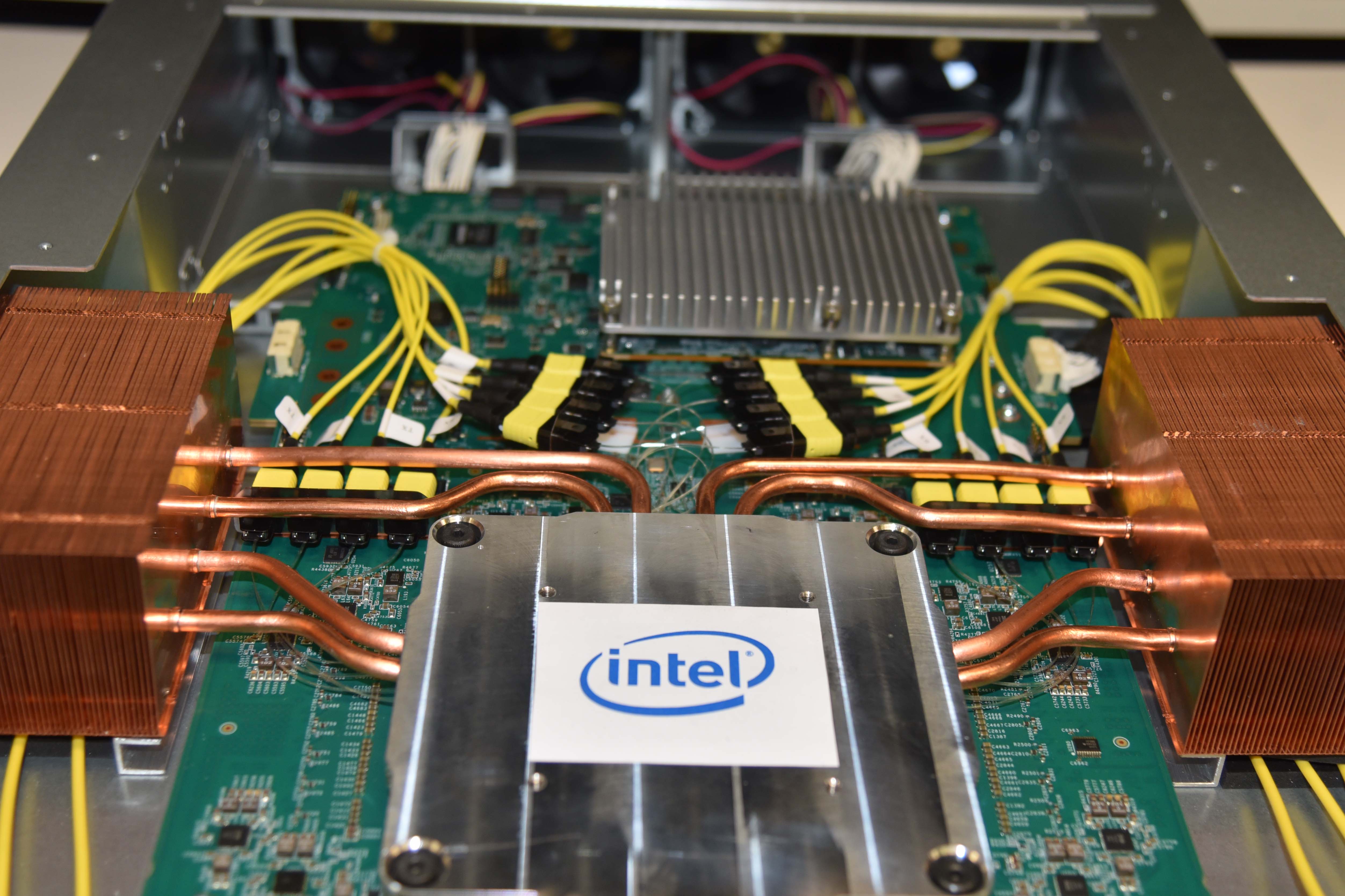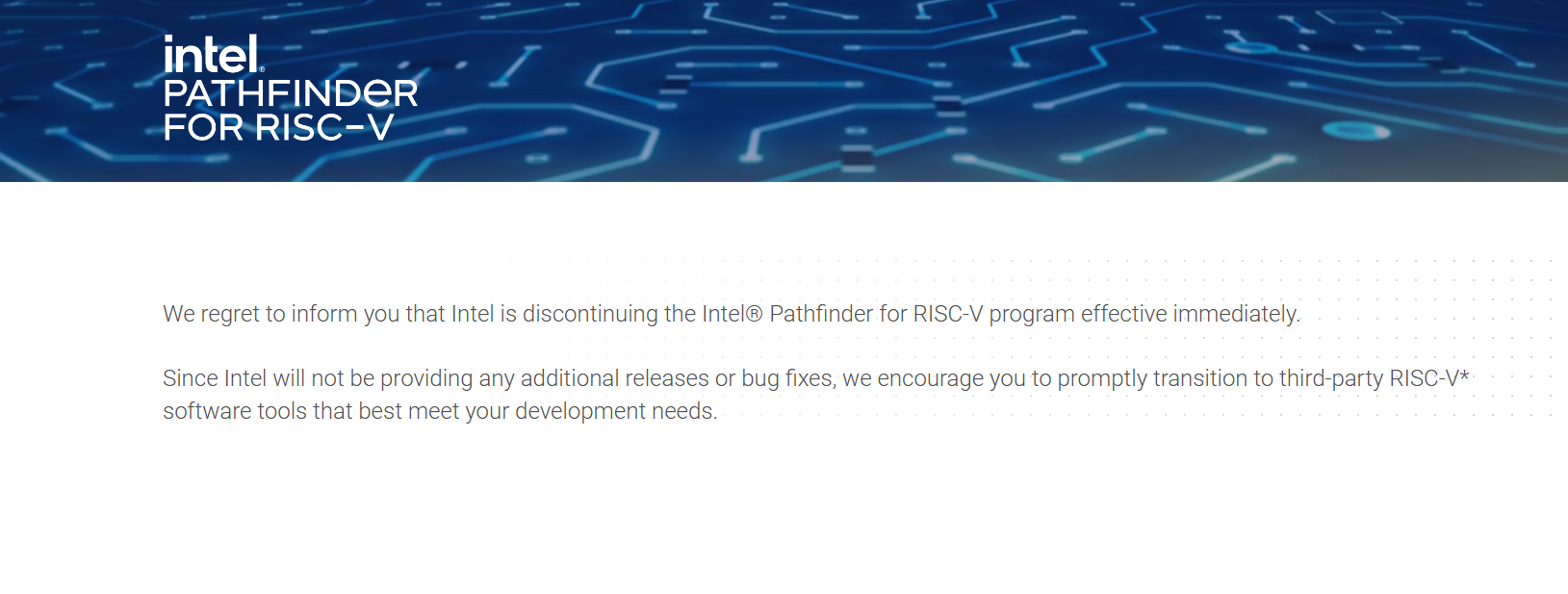Intel Sunsets Network Switch Biz, Kills RISC-V Pathfinder Program (Updated)
The axe is swinging.

Update 1/28/2022 6am PT: An Intel representative responded to our queries, telling us that the decision to end the Intel Pathfinder for RISC-V has no impact on Intel Foundry Services (IFS) or the Horse Creek platform. The company is still committed to supporting silicon on all three major instruction sets — x86, Arm, and RISC-V. The representative indicated that Pathfinder was an 'innovation project' from a small team at Intel, but didn't divulge a specific number of employees. We've also adjusted the text below accordingly.
Original Story 1/26/2022 8pm PT:
Intel's disastrous Q4 2022 earnings found the company losing $661 million and its margins crashing to the lowest point in decades, so it isn't surprising that the company announced new cost-cutting measures. That includes news that it would no longer invest in new products for its networking switch business, effectively sunsetting the unit much like it recently decided to end its Optane Memory business. Surprisingly, Intel also pulled the rug from under its respected RISC-V Pathfinder program without a formal announcement.
"NEX continues to do well and is a core part of our strategic transformation, but we will end future investments in our network switching product line, while still fully supporting existing products and customers," said Intel CEO Pat Gelsinger. "Since my return, we have exited seven businesses, providing in excess of $1.5 billion in savings," he added. However, Gelsinger also noted that he is still doing a thorough analysis across Intel's portfolio to look for other cost-saving measures in areas that don't generate strong returns.
Intel's networking switch business stems from acquiring Barefoot networks in 2019 for an undisclosed sum (the company had raised $144 million over several investment rounds). The Tofino series of network switches gave Intel yet another tool in its arsenal of data center 'adjacencies' that it could leverage to expand its data center revenue. However, this unit faces stiff competition from entrenched players like Broadcom, Cisco, and Nvidia's Mellanox, making it an easy cost-cutting target.
Intel did appear to invest in the network switch business for the long haul — the company had even demonstrated integrating its own silicon photonics engines into the Tofino switches, making it a key addition to its existing lineup of silicon photonics tech. Intel also later developed the Tofino 3 switch. That development work now ends as Intel winds that business down. In the meantime, Intel will continue to support its existing customers and products and also says it will intensify its focus on developing its new IPUs. There's no word on how many Intel employees could face layoffs as a result of the action.
The network switch business marks the seventh non-core business Intel has ended since Pat Gelsinger's arrival, including winding down Optane Memory production, jettisoning the company's drone business, and selling the SSD storage unit to SK Hynix to generate $1.5 billion for investment in areas that are core to Intel's business. Intel has also placed workers on voluntary leave and laid off 544 workers in California while deciding to shelve plans for a mega-lab in Oregon and cancel its planned development center in Haifa.

Intel also surprisingly ended its Intel Pathfinder for RISC-V program without any public statements, aside from sudden notices to participants that the company had discontinued the program. A visit to Intel's Pathfinder website finds the above notice that "Intel is discontinuing the Intel Pathfinder for RISC-V Program effective immediately." Intel's site also cautions that "Since Intel will not be providing any additional releases or bug fixes, we encourage you to promptly transition to third-party RISC-V software tools that best meet your development needs."
Intel abandoned pathfinder for RISC-V Program pic.twitter.com/jPGZ6JhCe9January 26, 2023
The Pathfinder program was a show of goodwill from the x86-exclusive Intel to the RISC-V community as it looks to foster an ecosystem of customers for its Intel Foundry Services (IFS). The program created a unified development environment for both industrial users and hobbyists, so it was split into two tiers — a Professional Edition for industry users, and a Starter Edition for researchers and hobbyists.
The program began in August 2022 and was meant to help accelerate the development of RISC-V chips through a unified integrated development environment (IDE) using industry-standard toolchains. The tools allowed users to build RISC-V chips and then run them on an FPGA. Many of the large RISC-V companies, not to mention RISC-V International, supported the program.
Intel also has many other RISC-V initiatives underway. Intel and SiFive just jointly announced the HiFive Pro P550 RISC-V development board a mere three days ago, and it is scheduled to be available this summer. The board is powered by a Horse Creek processor fabbed on the Intel 4 process by Intel Foundry Services. Intel also has a joint investment with the Barcelona Supercomputing Centre (BSC) to build a $426 million laboratory to develop RISC-V processors for future zettascale supercomputers, AI accelerators, autonomous vehicles, and high-performance computing.
Intel even created a $1 billion fund to help companies develop a wide range of chips that it will build in its IFS foundries, including x86, Arm, and RISC-V designs.
Gelsinger's comments that Intel is also looking for other cost-cutting targets across the company mean that we could see further cuts in the future.
Get Tom's Hardware's best news and in-depth reviews, straight to your inbox.

Paul Alcorn is the Editor-in-Chief for Tom's Hardware US. He also writes news and reviews on CPUs, storage, and enterprise hardware.
-
InvalidError If you put all of your eggs in the same "high return" basket, you are setting yourself up for a hard crash-and-burn should anything happen to that basket such as the current downturn in demand for all things x86 and GPUs.Reply -
setx Cutting RISC-V looks silly: it might not be high-margin area for Intel CPUs/chipsets, but it could become high-volume external demand for their foundry.Reply -
InvalidError Reply
Intel can fab others' RISC-V designs without developing its own RISC-V stuff. TSMC has little to no design input in its customers' design besides providing them with the primitives libraries to plug into their EDA tools so they can spit out physical designs from HDL.setx said:Cutting RISC-V looks silly: it might not be high-margin area for Intel CPUs/chipsets, but it could become high-volume external demand for their foundry. -
DuelMaster Intel is sacrificing the long term benefits to please the shareholders in the short term. Eliminating all of these businesses will eliminate what makes Intel "special". There was nothing like Optane memory in the industry. The elimination of their storage business with the Optane business eliminates any chance for them to create a unique product in the space. They could have made serious gains in the networking switch space because of their unique position as a processor business. In regards to the processor business, their decision with the RISC-V pathfinder business is strange to me. RISC-V is increasingly looking to be the future of computing. I am also seriously concerned for Arc graphics with those losses that they posted with the graphics team as mentioned in another article. Intel, in its efforts to reduce losses, may end Arc graphics and any chance to eventually make it in that space with it. I don't know. I'm not an analyst or one of the people on leadership or finance at Intel or anything like that, but I think they need to start telling investors that their businesses are in it for the long term, not the short term. The continued shortsightedness could be the slow death of Intel.Reply -
kjfatl Is is possible that potential customers look at Intel's RISC-V as a direct competitor to their business model? If so, dropping the Intel IISC-V business might get 3 or 4 RISC-V IP suppliers to target Intel's fabs instead of just TSMC and Samsung.Reply -
bit_user Reply
They're not. They're just cutting an IP-neutral SDK that they put together for it.setx said:Cutting RISC-V looks silly:
I'd never heard of Pathfinder. Here's how Intel described it:
"Designed for SOC architects and system software developers, Intel Pathfinder for RISC-V is a pre-silicon development environment that supports IP selection via testing for compatibility and performance, as well as early-stage software development using Intel FPGA and simulator platforms."
That ties in nicely with what the article said about it.
Regarding RISC-V, what Intel cancelled was a small potatoes development tool. This Barcelona Supercomputing Center project sounds very interesting, and potentially much more relevant to their long-term strategic interests in this area.DuelMaster said:their decision with the RISC-V pathfinder business is strange to me. RISC-V is increasingly looking to be the future of computing.
BTW, the RISC-V Pathfinder program was aimed mostly at helping people get started on developing for non-Intel RISC-V cores. Were Intel to launch its own RISC-V IP, Pathfinder would run somewhat contrary to its interests. As such, it could signify Intel leaning into the space, rather than backing away from it. I don't put much stock in that take, but it might be something. -
bit_user Reply
I think Gelsinger is looking at their strategic interests and cutting anything that's not. For now, their discrete graphics business appears to be safe.DuelMaster said:Intel is sacrificing the long term benefits to please the shareholders in the short term.